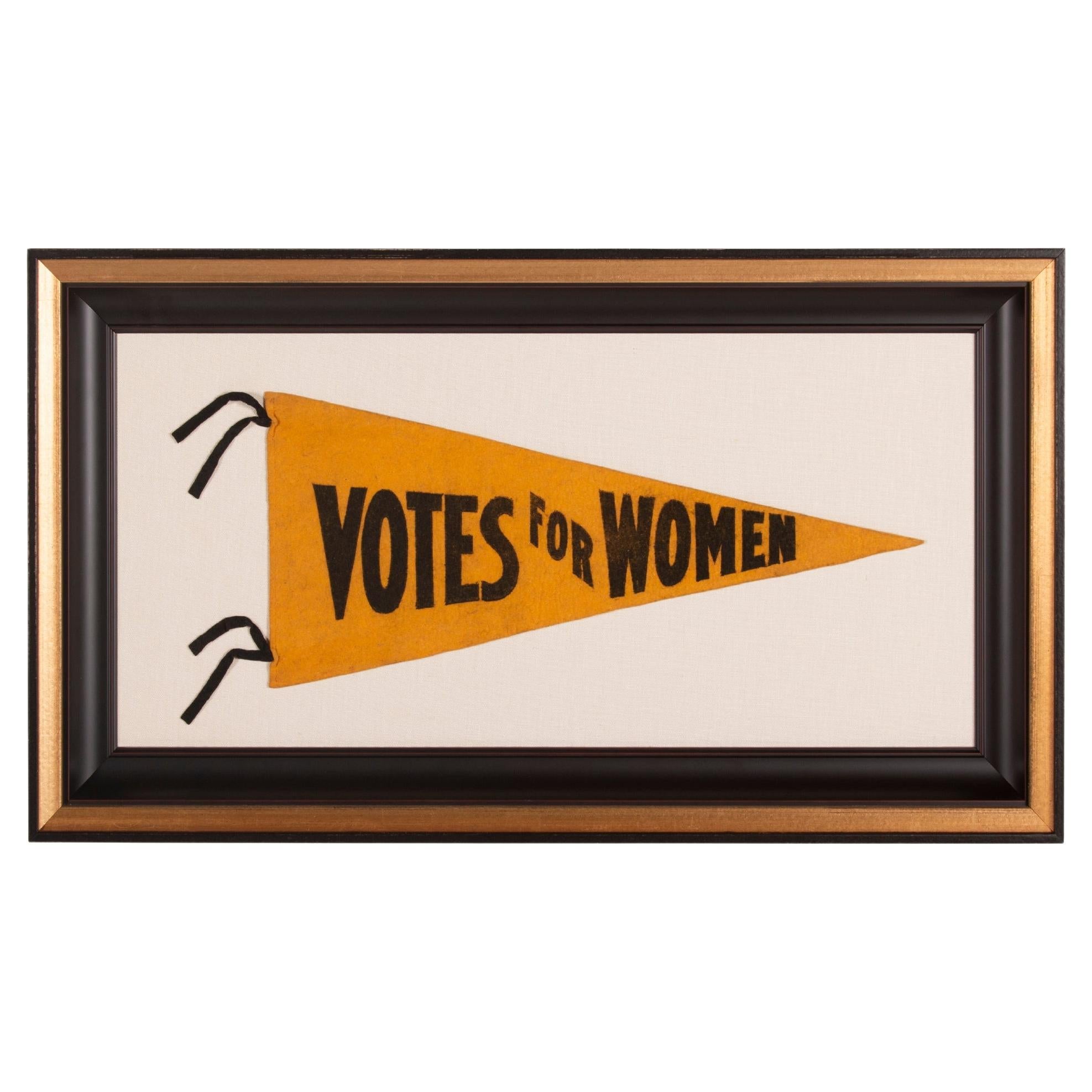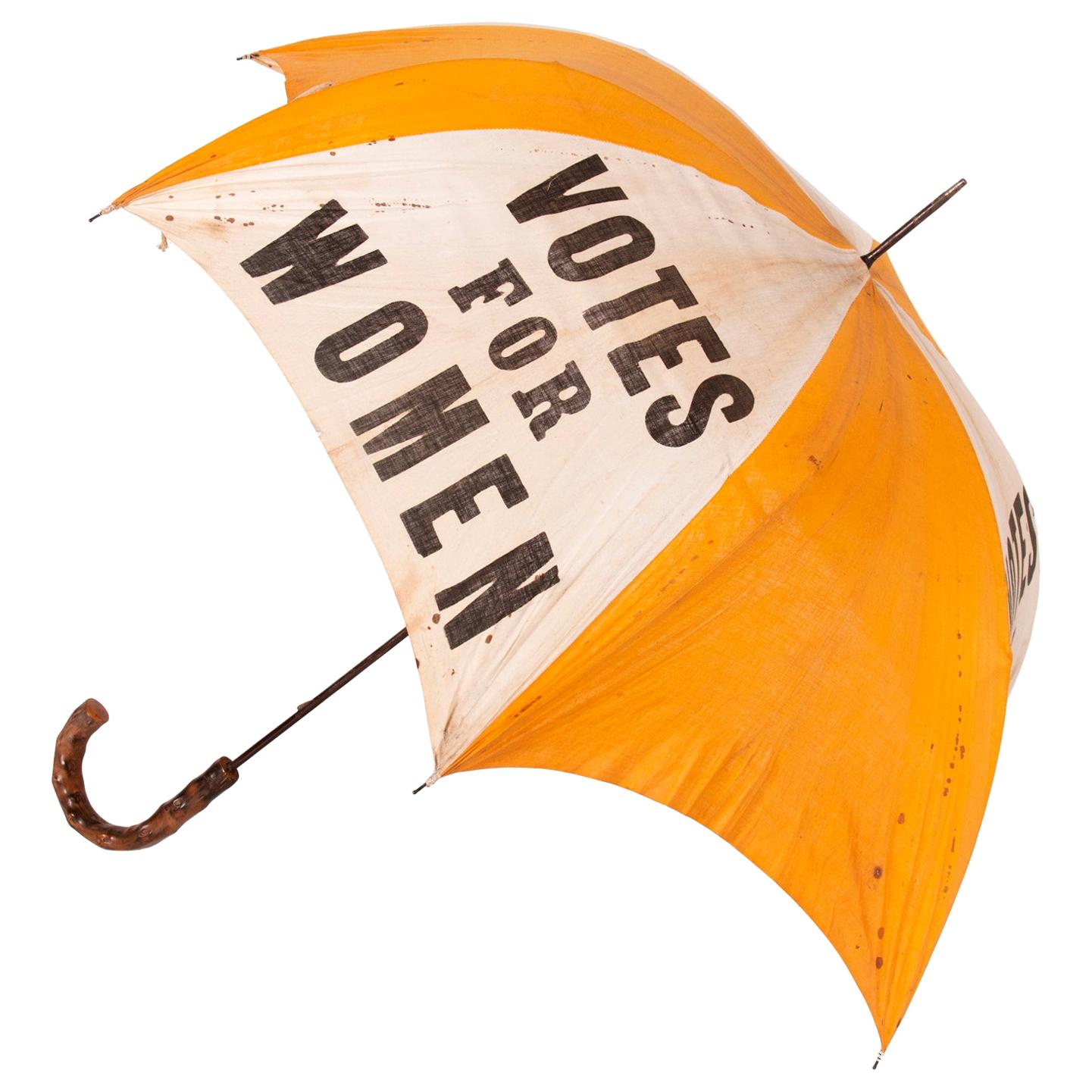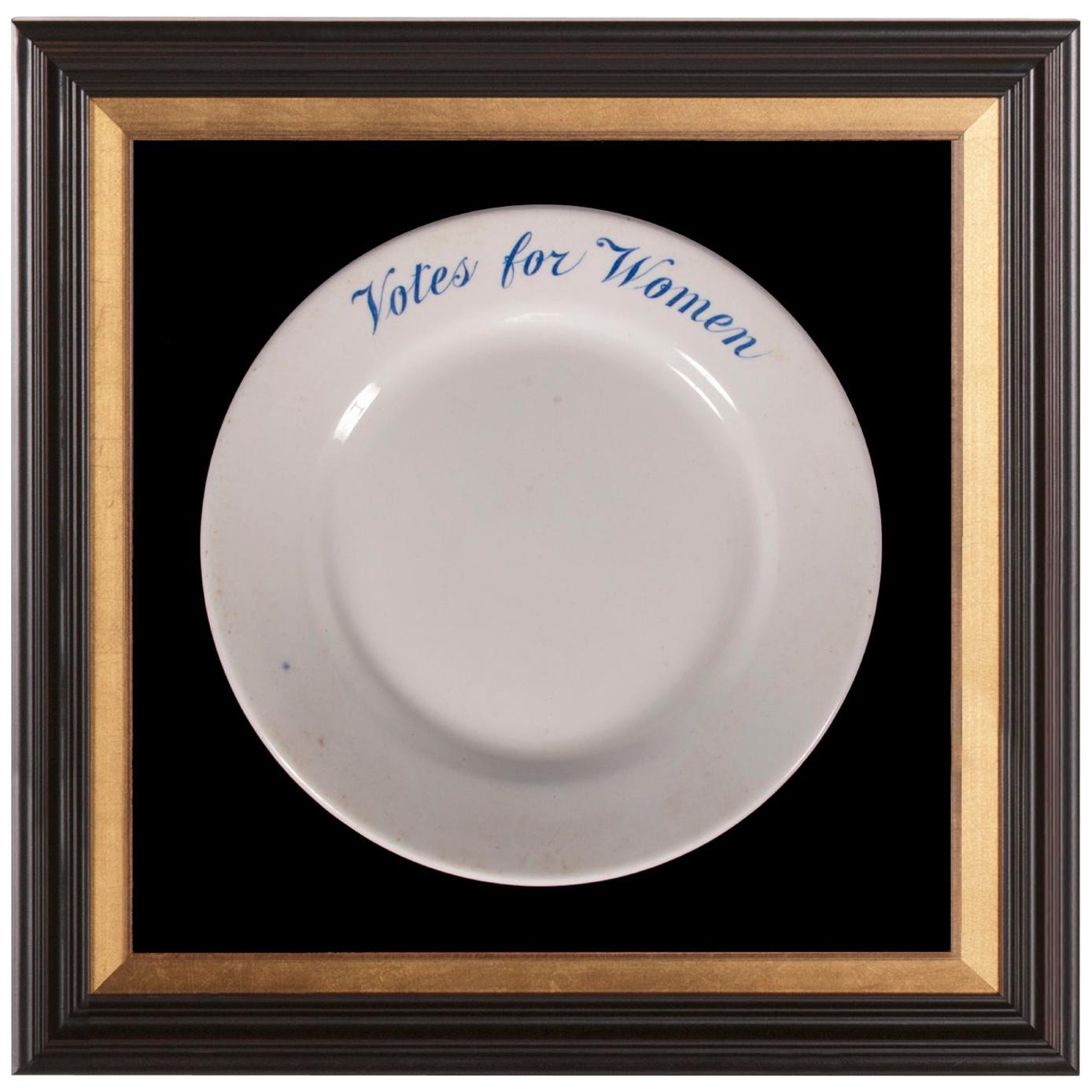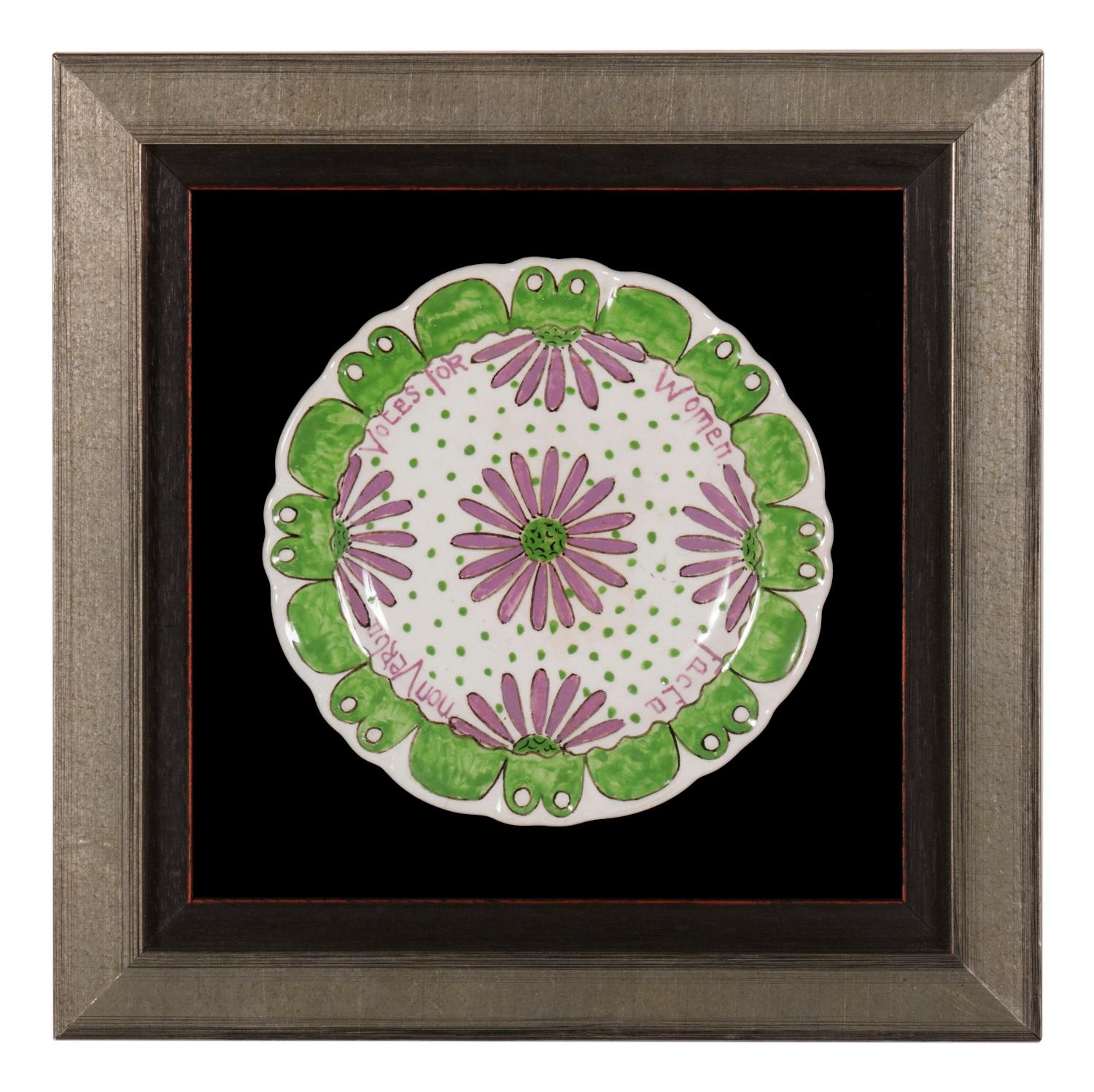Items Similar to "Votes for Women" Sash in Yellow and White, ca 1910-1915
Want more images or videos?
Request additional images or videos from the seller
1 of 5
"Votes for Women" Sash in Yellow and White, ca 1910-1915
About the Item
Silk suffragette sash ribbon in yellow & white with "votes for women" text, circa 1910-1915
Section of wide, silk, grosgrain ribbon, of the type often worn as a sash, in a deep, saturated shade of golden yellow, with printed, black, Roman letters that reads "Votes for Women." Made for the Suffragette movement, ribbon of this style was usually sold by length. Most often, in the States, segments with just one instance of the “Votes for Women” slogan are most often encountered. These were pinned diagonally across the breast, instead of wrapped all the way around, likely with the notion of frugality, and to have more ribbon distributed, so that more participants could display them in parades and rallies, or because this was less costly, or for both of the above reasons. Wrap-around sashes are rare, required a lot more fabric, as well as some stitching and the inclusion of a special, metal clip. Because this textile could be employed for whatever use the purchaser desired, sometimes it was undoubtedly affixed around a hat or worn as an armband.
Golden yellow was the customary color of the suffrage movement in America, a tradition began with the first actual campaign to give women the right to vote. This took place in 1867 in Kansas, the first state to hold a referendum on the issue, when suffragists Susan B. Anthony and Carrie Stanton focused their efforts there and wore sunflowers—the state flower—in a show of support, as well as yellow ribbons. The flower was an appropriate emblem for a rising sun and growth, which led to its use in other states, and the carryover of the color to many other objects of the campaign for years to come. In England, green, white, and purple / violet were introduced in 1908 and became the colors of the movement, which gave way to a nice acronym for “Give Women the Vote”, though various groups used these also in the States, sometimes substituting golden yellow for green. Some American groups distinguished themselves by the use of different colors.
Many of the sashes or sash ribbons I encounter in the States are violet and green, made specifically for the Women’s Political Union of New York, Connecticut, and New Jersey. This color scheme is not only far and away more scarce, but graphically superior in my opinion, with tremendous color, in a beautifully saturated shade of golden yellow, that contrasts wonderfully with the white ground and black lettering.
Mounting: The textile was mounted and framed within our own conservation department, which is led by expert staff. We take great care in the mounting and presentation of flags and related textiles and have preserved thousands of examples.
The background is 100% cotton twill, black in color, that has been washed and treated for colorfastness. The mount was then placed in a modern molding with a step-down profile, with a finish that is very dark brown, nearly black, with red with a red undertones and highlights. The glazing is U.V. protective acrylic (Plexiglas).
Condition: Exceptional, with only the most minor soiling and oxidation, almost not worth mention. A near “10” among its counterparts.
- Dimensions:Height: 9 in (22.86 cm)Width: 30.5 in (77.47 cm)Depth: 2 in (5.08 cm)
- Materials and Techniques:
- Place of Origin:
- Period:1910-1919
- Date of Manufacture:1910-1915
- Condition:See Item Description.
- Seller Location:York County, PA
- Reference Number:
About the Seller
5.0
Recognized Seller
These prestigious sellers are industry leaders and represent the highest echelon for item quality and design.
Established in 1991
1stDibs seller since 2008
61 sales on 1stDibs
Typical response time: 11 hours
- ShippingRetrieving quote...Ships From: York County, PA
- Return PolicyThis item cannot be returned.
More From This SellerView All
- "Votes for Women: Suffrage Pennant ca 1912-1920Located in York County, PAAmerican Suffrage movement pennant, with a standard, triangular taper. Made of yellow felt, with tapered letters that read simply: "Votes for Women," bo...Category
Early 20th Century American Political and Patriotic Memorabilia
MaterialsFelt
- Rare Yellow & White Suffrage Parasol with "Votes for Women" TextLocated in York County, PAEXTRAORDINARILY RARE, YELLOW & WHITE, SUFFRAGE PARASOL / UMBRELLA, WITH “VOTES FOR WOMEN” TEXT, DISTRIBUTED BY THE NATIONAL AMERICAN WOMEN’S SUFFRAGE ASSOCIATION UNDER ANNA HOWARD SHAW’S LEADERSHIP [HEADQUARTERED IN NEW YORK], CIRCA 1913-1915: In the world of Suffrage memorabilia, parasols and umbrellas are known to have been produced, but hardly any exist. Made in both Britain and America, most of the organizations known to have commissioned them did so with white or purple, green, and white, utilizing the traditional British colors. In America, some of these can be identified to the Women’s Political Union of New York, New Jersey, and Connecticut. As for those in the traditional American colors of golden yellow and white, typically with black text, examples are known to have been produced and sold by the National American Women’s Suffrage Association (NAWSA), beginning in the summer of 1913. According to author and expert Ken Florey, the organization peddled them for “one dollar each or ten dollars a dozen…[promoting] them as good for advertising the cause at street meetings, summer resorts, and county fairs. The design consisted of yellow and white in alternate sections, with “Votes for Women” in the white sections.” Florey goes on to explain how some umbrellas in this style are known with names of states hand-painted in the yellow panels. I am aware of Oregon and Idaho. Florey also indicates that one is known for Alaska. His discussion of the subject, and an illustration of the Idaho example, appear in his book, "Women's Suffrage Memorabilia" (2013, McFarland & Co., North Carolina), on pp. 192 and A8, respectively. The Oregon example, which have seen and held first-hand, is illustrated in "The Keynoter: Journal of the American Political Items Conservators," Summer/Fall/Winter 2008 (Women's Suffrage Special Triple Issue), Vol. 2008, No. 2-4, p. 110. In “Woman Suffrage Memorabilia,” Florey describes a heavy demand for parade accoutrements in the 19-teens. Despite the supposed numbers in which these yellow and white umbrellas were likely to have been produced, this is the only example that I am aware has actually surfaced with the “Votes for Women” text only and no state names. This makes it far more universally desirable. A period image survives in the Albert R. Stone Negative Collection, Rochester Museum & Science Center (Rochester, New York,) of a women carrying parasols in this style on Main Street West in that city on August 15, 1914. The marchers, masked, were described as wearing yellow dominoes (nun-style dresses) and carrying yellow parasols. According to museum catalogers, “The outside parasols are plain; those on the inside have the inscription, "Votes for women". The first group, in yellow and blue dominoes, advertised the speech and visit of Dr. Anna Howard Shaw [this would be members of the Empire Campaign Committee]. The second group carried placards with the names of equal suffrage states and the dates when they adopted votes for women. The Club Theatre, whose sign advertising "Burlesque" is clearly visible behind the marchers, occupies the premises at 75 Main Street West formerly occupied by the Shubert Theatre.” The National American Women’s Suffrage Association was formed in 1890. It represented a merging of the two largest Suffrage groups in America before that time. These were the National Woman Suffrage Association (NWSA), formed in 1869 by Susan B. Anthony and Elizabeth Cady Stanton, and the American Woman Suffrage Association (AWSA), also formed in 1869 by Lucy Stone and her Husband, Henry Brown Blackwell, Henry Ward Beecher, and others. Stone’s daughter, Alice Stone...Category
Mid-20th Century North American Political and Patriotic Memorabilia
MaterialsCotton
- Ironstone Suffragette Plate w/ Votes for Women Text, Made for Alva Belmont, 1914Located in York County, PAIRONSTONE PLATE WITH "VOTES FOR WOMEN" TEXT, MADE JOHN MADDOCK & SONS FOR SUFFRAGIST ALVA BELMONT FOR MARBLE HOUSE, HER FAMOUS ESTATE IN NEWPORT, RHODE ISLAND, CIRCA 1914: Porcelain objects related to the Suffrage movement are extremely scarce. The most celebrated of all American suffrage dinnerware consists of a service of white ironstone, commissioned by Alva Belmont,* prominent Newport, Rhode Island, socialite. Belmont was the founder of a pro-suffrage group called the Political Equality Association. According to Suffrage memorabilia expert Ken Folley, "There are at least eight different examples known in this design, including a cup and saucer, a lunch or dinner plate, a salad or bread plate, a berry bowl, a soup bowl, a celery dish...Category
Vintage 1910s English Political and Patriotic Memorabilia
MaterialsPorcelain
- Suffragette Plate, "Deeds Not Words" & "Votes for Women", The Only Known ExampleLocated in York County, PAENGLISH PORCELAIN SUFFRAGETTE PLATE WITH "DEEDS, NOT WORDS" AND "VOTES FOR WOMEN" SLOGANS, ONE-OF-A-KIND AMONG KNOWN EXAMPLES, CA 1905-1918 English porcelain plate, made for the Wo...Category
Early 20th Century English Political and Patriotic Memorabilia
MaterialsPorcelain
- Violet & Yellow Suffragette Parade Banner, Ca 1910-1920Located in York County, PARare violet & yellow Suffragette parade banner, the plate example illustrated in the text reference on the subject, made ca 1910-1920. Hand-painted banners...Category
Early 20th Century Political and Patriotic Memorabilia
MaterialsSilk
- Paper Suffrage Pennant with Bold and Whimsical Western Style Lettering, ca 1915Located in York County, PAUnusual paper suffrage pennant, with bold and whimsical, western style lettering, circa 1915 American Suffragette pennant, in a very rare format, with text that reads “Votes for Women,” in a combination of two bold, Western-style fonts. Made of golden yellow paper, with the lettering printed in black, the profile is an unusual one. Linear for approximately 2/5 of its length, the remainder tapers to a point. An example in this style is documented in "The Keynoter: Journal of the American Political Items Conservators," Summer/Fall/Winter 2008 (Women's Suffrage Special Triple Issue), Volume 2008, Number 2-4, p.133. This periodical is the best printed reference that presently exists on Suffrage objects. Golden yellow was the customary color of the suffrage movement in America, a tradition that began with the first actual campaign to give women the right to vote. This took place in 1867 in Kansas, the first state to hold a referendum on the issue when suffragists Susan B. Anthony and Carrie Stanton focused their efforts there and wore sunflowers—the state flower—in a show of support, as well as yellow ribbons. The flower was an appropriate emblem for a rising sun and growth, which led to its use in other states, and the color carried over to many other objects employed in the campaign for years to come. In England, green, white, and purple / violet were introduced in 1908 and became the colors of the movement, which gave way to a nice acronym for “Give Women the Vote.” Various groups used these colors also, in the States, sometimes substituting golden yellow for green. Mounting: The textile was mounted and framed within our own conservation department, which is led by expert staff. We take great care in the mounting and presentation of flags and related textiles and have preserved thousands of examples. This is a pressure mount...Category
Vintage 1910s American Political and Patriotic Memorabilia
MaterialsPaper
You May Also Like
- Antique 13-Star Patriotic Sash by Louis E. Stilz & Bros., Early 20th CenturyLocated in Colorado Springs, COPresented is an original patriotic sash from the early 20th century, featuring 13 stars against a bright blue field. This sash features appliqued silver stars on a blue canton, red a...Category
Early 20th Century American Historical Memorabilia
MaterialsCotton
- French Women Bust Sculpture "Marianne" Godess of Liberty in Solid Wood, 1960sLocated in Antwerp, BEVintage French bust sculpture of a woman Marianne has been the national personification of the French Republic since the French Revolution, as a personification of liberty, equality, fraternity and reason, and a portrayal of the Goddess of Liberty...Category
Vintage 1960s French Mid-Century Modern Busts
MaterialsWood
- Antique Reverse Printed Commemorative Panel for Admiral Lord Nelson's DeathLocated in Hamilton, OntarioThis framed antique and reverse printed panel was produced in England in the early 20th century by an unknown maker to commemorate the death of Admiral Lord Nelson...Category
Early 20th Century English Edwardian Prints
MaterialsPaper
- 46-Star American Flag Printed in Drum Star ConfigurationLocated in Colorado Springs, COThis is an original 46-Star American parade flag, celebrating Oklahoma statehood. Each star on the flag's canton represents a state in the Union at the time. The official flag design would update every July 4th, to include any new states added to the Union in the past year. Oklahoma, the 46th state, entered the Union on November 16, 1907. As such, this 46–star flag was the official flag of the United States from July 4, 1908, until July 4, 1912. The silk flag has a dark blue canton with 46 white printed stars. The stars are printed in an 7-8-8-8-8-7 row configuration, or “Drum design.” The flag design is completed with 13 alternating red and white stripes, each stripe representing one of the original thirteen colonies. The land that comprises Oklahoma today was added to the United States as part of the Louisiana Purchase of 1803. Throughout the 19th century, the U.S. government relocated Indian tribes from the southeastern United States to the area, and by 1900, over 30 Indian tribes had been moved to what was originally called the Indian Territories. At the same time, ranchers in Texas began to move into the area in search of new pasture lands. Although stipulations in the Indian Relocation Act agreed that the land would forever be Indian Territory, the promise of fertile farmland trumped the government’s promise of sovereignty. On April 22, 1889, they opened the land to settlement by homesteaders, creating a land run in which settlers, called “Boomers,” were allowed to cross the Texas or Arkansas border at a particular hour to claim homesteads. Settlers who illegally crossed the border earlier to stake prime land were called “sooners,” which eventually became the state’s nickname. Wagons and the Santa Fe railroad carried cartloads of men and women to blank town sites and building plots, creating ten thousand-people communities in a matter of days. The following year, the region was further divided into Indian Territory and Oklahoma Territory...Category
Vintage 1910s American Political and Patriotic Memorabilia
MaterialsSilk
- Patriotic Quilt Titled "Stars and Stripes" ForeverLocated in Darnestown, MDThis fabulous 48 star Patriotic quilt has the embroidered title "Stars and Stripes Forever." The stripes of the flag are created in an unusual way. Rather than using horizontal stri...Category
Vintage 1920s American Quilts
MaterialsCotton
- Vintage Fante People Asafo Flag in Cotton Applique Patterns, Ghana, 1930-1950sBy Fante PeopleLocated in Copenhagen K, DKGhana, 1930s-1950s Asafo flag “The train is always ready to go” in cotton applique patters. Trains were a dramatic expression of power, regularity and reliability and as such were ...Category
Mid-20th Century Ghanaian Political and Patriotic Memorabilia
MaterialsCotton
Recently Viewed
View AllMore Ways To Browse
Women Made
Women In Yellow
England 1910
Women Used As Furniture
1910 Metal
1910 Metal Furniture
Very Rare 1910
Silk Sash
Antique Patriotic Memorabilia
Silk White Down
Antique White Wash
United States Framed Flag
Framed Patriotic Flag
Antique Framed American Flag
Antique American Flag Framed
Antique White Washed Furniture
White Wash Antique Furniture
Purple And White Fabric





